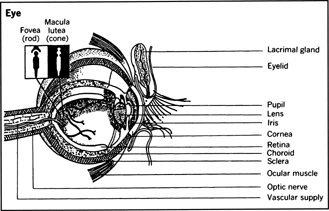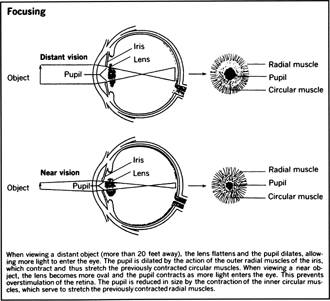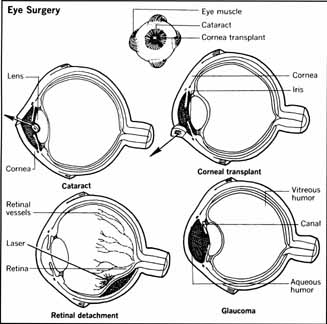Diseases of the Eye and Ear - The eyes
All sensations must be processed in the brain by a normally functioning central nervous system for their proper perception. In addition, each sensation is perceived through a specific sense organ. Thus, sight is dependent on at least one functioning eye.
The eye is an optical system that can be compared to a camera, because the human lens perceives and the retina receives an image in the same way that a camera and its film does. Defects in this optical system are called errors in refraction and are the most common type of sight problem.
Myopia
Nearsightedness or myopia is a refractive error that causes faraway objects to be seen as blurred and indistinct. The degree of nearsightedness can be measured by testing each eye with a Snellen Test Chart. Normal vision is called 20/20. This means that at 20 feet the eye sees an image clearly and accurately.
Eyesight of less-than-normal acuity is designated as 20/50 or 20/100 and so on. This means that what the deficient eye can see accurately at a distance of 20 feet or less, the normal eye can see accurately at 50 or 100 feet.
Myopia, the most common of all refractive errors, results from an elongation of the eyeball that prevents images from being focused on the retina. Myopia usually develops between the ages of 6 and 15. Prescription eyeglasses or contact lenses can correct the refractive error.
Other corrective measures involve physically altering the shape of the cornea. In radial keratotomy, the cornea is flattened through surgical cuts in order to change the way light is bent by the eye. This technique is rarely performed, as it severely weakens the cornea. A revolutionary alternative to radial keratotomy is laser surgery. A laser beam trims and sculpts the cornea in seconds.
Farsightedness and Astigmatism
The opposite of myopia is hyperopia , or farsightedness, which results from a shortening of the eyeball. The two conditions may be combined with astigmatism , in which vertical and horizontal images do not focus on the same point, mainly because of some abnormality of the front surface of the cornea. Properly fitted glasses can correct all of these deficiencies.
Presbyopia
A fourth refractive error combines with the other three to make up about 80 percent of all visual defects. It is known as presbyopia , or old-sight, and results from an inability of the lens to focus on near objects. Almost everyone is affected by presbyopia some time after the age of 40, because of the aging of the lens itself or the muscles which expand and contract it. Presbyopia can be easily corrected with glasses.
All these conditions represent variations in the sight of one or both eyes from what is considered the norm.
Because seating distance from a school blackboard, the size of print, and the distance at which signs must be read are all based on what is considered to be normal vision, eye defects are handicaps, some mild and some severe.

Many people can function normally without glasses if the defects are minor. But because uncorrected refractive errors can cause headaches and general fatigue as well as eye aches and eye fatigue, they should receive prompt medical attention.
Color Blindness
Color blindness is a visual defect that occurs in about eight percent of men but is extremely rare in women. It is hereditary, and usually involves an inability to differentiate clearly between red, green, and blue. It is a handicap for which there is no known cure at the present time.
Glaucoma
Glaucoma is a serious problem that affects about two percent of those people who are over 40. It is caused not only by the aging process, but also and more importantly by anatomical changes inside the eye that prevent the normal drainage of fluid. The pressure inside the eye is therefore increased, and this pressure causes further anatomical change that can lead to blindness.
Glaucoma may begin with occasional eye pain or blurred vision, or it may be very insidious, cause no symptoms for years, and be discovered only at an eye examination. Glaucoma is the number one cause of blindness, and an annual check for its onset by a specialist is particularly recommended for everyone over 40. The test is quick, easy, and painless, and should symptoms appear, early treatment, either medical or surgical or both, can reduce the likelihood of partial or complete loss of sight.

Cataracts
Another serious eye problem is the development of cataracts . These are areas in the lens that are no longer transparent. The so-called senile cataract is common among elderly people because of degenerative changes in the lens. The condition causes varying degrees of loss of vision which are readily noticed by the patient. If the vision is reduced a great deal, the entire lens can be removed surgically and appropriate glasses or contact lenses can be provided.

Detached Retina
Among the most serious eye disorders is the condition known as separated or detached retina . It occurs when fluid from inside the eye gets under the retina (the inner membrane at the back of the eye, on which the image is focused) and separates it from its bed, thus breaking the connections that are essential for normal vision. The most common cause of the detachment is the formation of a hole or tear in the retina. However, the condition may also develop following a blow to the head or to the eye, or because of a tumor, nephritis, or high blood pressure.
The symptoms of the onset of retinal separation are showers of drifting black spots and frequent flashes of light shaped like pinwheels that interfere with vision. These disturbances are usually followed by a dark shadow in the area of sight closest to the nose.
A retinal detachment is treated by surgical techniques in which the accumulated fluid is drained off and the hole in the tissue is sealed. About 60 percent of all cases are cured or considerably improved after surgery. The earlier the diagnosis, the more favorable is the outcome. Proper postoperative care usually involves several weeks of immobilization of the head so that the retinal tissue can heal without disturbance.
Trauma
Like any other part of the body, the eye can be injured by a major accident or trauma , although it is somewhat protected by the bones surrounding it. Trauma can cause most of the problems previously described. In addition, small objects can get into the eye easily, and particles of soot and other wind-borne dirt can cause great discomfort. The tearing that results from the irritation usually floats foreign substances away, but occasionally they have to be removed by an instrument.
When a particle in the eye or under the eyelid is not easily dislodged and begins to cause redness, it should be removed by someone qualified to do so. The eye should never be poked at or into by untrained hands.
Leaving contact lenses in the eye for too long can cause discomfort that lasts for quite a while even after they have been taken out. Bacterial or viral infections of the outer surface of the eye such as conjunctivitis or pinkeye , or of the eyelids, are quite common and should be treated by a physician if they are extensive or chronic.
Contact Lenses
Contact lenses, which are fitted directly over the iris and pupil of the eye in contact with the cornea (the tissue covering the outer, visible surface of the eye), are preferred by some people for the correction of vision defects. In some cases of severe astigmatism or nearsightedness, or following cataract surgery, contact lenses can be more effective and comfortable than eyeglasses. But the chief reason for their popularity has been cosmetic. They are practically invisible.
Hard contact lenses adhere to the eye by suction; a partial vacuum is created between the inner surface of the lens and the outer surface of the eyeball.
Soft plastic contact lenses are hydrophilic (literally, water-loving) and adapt their shape to the shape of the moist cornea, to which they adhere. Thus they are relatively easily fitted, and patients seldom experience discomfort in adjusting to them. It is virtually impossible for dust particles to get under them. Many ophthalmologists, however, advise that the soft lens be sterilized daily.
The soft lens has proved valuable in the treatment of some eye disorders. But it often leads to problems among wearers. It may scratch or tear, for example, and generally it has been limited to the correction of certain kinds of nearsightedness and farsightedness.

Extended wear lenses (EWLs) were introduced in the 1970s. Made of soft plastic like the older lenses, but thinner and more porous, they could be worn as long as 30 days. But wearing EWLs too long was found to cause such problems as scarring of the cornea; neurovascularization, the growth of tiny blood vessels that can cloud the vision and in extreme cases threaten the wearer's sight; the development of microcysts during sleep; and bacterial infections of the eye or eyelid, such as Acanthamoeba keratitis .
Disposable lenses and cosmetic contacts appeared in the late 1980s. Worn for a week and then discarded, disposable lenses reduce the danger of keratitis and other infections. But they cost about 50 percent more than the regular EWLs. Cosmetic contacts simply change the color of the eyes. Disposables should not be worn longer than prescribed, and cosmetic lenses should not be shared to prevent the spread of eye diseases and other infections. Clean the lenses according to instructions and seek medical help quickly if problems arise.
Diseases That Affect Vision
In addition to the various disorders involving only the eye, there are a number of generalized diseases that affect vision. Among these are arteriosclerosis, diabetes mellitus, and hypertension or high blood pressure, which often cause abnormalities in the blood vessels of various parts of the eye. These abnormalities can lead to tissue changes that cause the patient to see spots or to notice that his vision is defective.
Diseases of the brain, such as multiple sclerosis, tumors, and abscesses, although rare, can result in double vision or loss of lateral or central vision. Any sudden or gradual changes in vision should be brought to a physician's attention promptly, since early diagnosis and treatment is usually effective and can prevent serious deterioration.

Comment about this article, ask questions, or add new information about this topic: